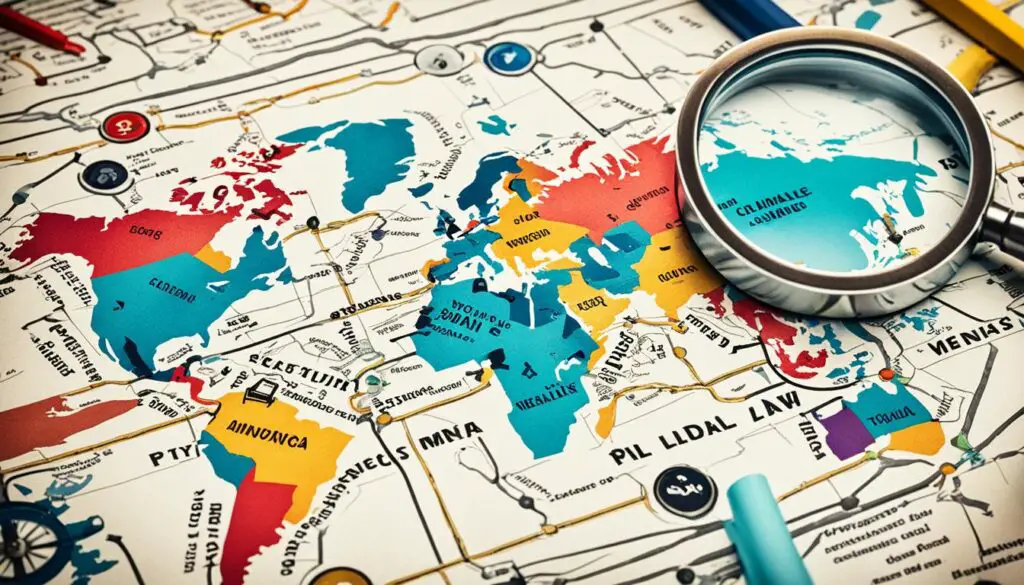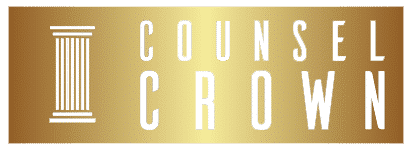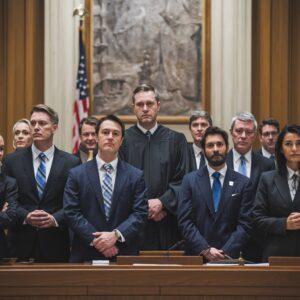
In today’s digital era, the internet has revolutionized communication and content sharing. The advent of social media platforms has provided individuals and businesses with unprecedented opportunities to connect with a global audience, express their opinions, and promote their products and services. However, with these opportunities come significant responsibilities and potential legal pitfalls.
Social media law encompasses the legal framework that governs online activities, ensuring the protection of individuals’ rights, intellectual property, and privacy in the digital realm. As content creators, it is essential to understand our online responsibilities and the legal repercussions of our actions to navigate this minefield effectively.
Whether you are an influencer sharing lifestyle tips, a brand engaging with customers, or a content creator sharing your creations, it is crucial to adhere to social media law to avoid potential legal issues. From copyright infringement to online defamation, there are various legal considerations that must be taken into account when creating and sharing content on social media platforms.
In this comprehensive guide, we will explore the complexities of social media law, providing valuable insights into navigating the legal landscape of the digital realm. From understanding the leaked content phenomenon to implementing strategies to protect your valuable content, we will equip you with the knowledge and tools necessary to thrive in the competitive digital landscape.
Key Takeaways:
- Understanding social media law is crucial for content creators in the digital age.
- Complying with online responsibilities and respecting individuals’ rights and intellectual property is essential.
- Leaked content can result in reputational harm and financial loss, understanding the legal implications is vital.
- Implementing strategies such as watermarking, copyright notices, and platform-specific security can protect your content.
- By navigating social media law and protecting your content, you can thrive in the digital realm while respecting the rights of others.
Understanding the Leaked Content Phenomenon
Leaked content is a pressing concern for content creators in the digital industry. The unauthorized sharing of digital content exposes creators to various risks, including financial loss, reputational harm, and invasion of privacy. To safeguard their work, content creators must fully grasp the legal and ethical implications associated with leaked content, such as copyright infringement and the rights pertaining to digital distribution.
The impact of leaked content cannot be underestimated. It has the potential to undermine the trustworthiness of a creator’s work, tarnish their reputation, and erode their audience base. The unauthorized sharing of content can also lead to the devaluation of intellectual property rights and disrupt the revenue streams of creators who rely on their work for income.
To combat the negative consequences of leaked content, content creators need to adopt proactive measures aimed at protecting their valuable creations. This can involve implementing strategies to deter unauthorized sharing, as well as taking legal action when necessary.
Protecting Intellectual Property Rights
One effective strategy content creators can employ is the use of visible and invisible watermarks. By embedding unique identifiers into their content, creators can trace the source of any leaks and establish ownership. Additionally, applying digital rights management tools can provide an extra layer of protection by restricting access to content and controlling its distribution.
Implementing copyright notices is another vital step in protecting content. These notices serve as a clear declaration of ownership and can act as a deterrent to potential infringers. By prominently displaying copyright information on their work, creators establish their rights and signal that unauthorized sharing will not be tolerated.
The unauthorized sharing of digital content can have far-reaching consequences for content creators. It is essential to take proactive steps to protect our valuable creations, uphold our intellectual property rights, and safeguard our reputation in the digital realm.
Building Platform-Specific Security
In addition to watermarking and copyright notices, content creators should leverage platform-specific security features to safeguard their work. These features can include measures to prevent screenshots, disable unauthorized downloads, and restrict content access. By utilizing these platform-specific security options, creators minimize the risk of their content being leaked or shared without permission.
Furthermore, content creators should stay updated on platform policies and terms of use to ensure they are leveraging the maximum protection available. Regularly reviewing and adjusting privacy settings, as well as monitoring for unauthorized use of content, can help maintain control over the distribution of valuable creations.
In summary, understanding the leaked content phenomenon is crucial for content creators striving to protect their work in the digital landscape. By employing a combination of protective strategies, including watermarking, digital rights management, copyright notices, and platform-specific security measures, creators can mitigate the risks associated with unauthorized sharing, safeguard their reputation, and preserve the value of their intellectual property.
Strategies for Protecting Your Content
As a content creator, it’s essential to take proactive measures to safeguard your valuable content from unauthorized sharing. By implementing various strategies, you can maintain control over the distribution of your content and protect it from leaks and unauthorized distribution.
Visible and Invisible Watermarks
One effective strategy is to apply visible and invisible watermarks to your content. Visible watermarks, such as logos or text overlays, act as a deterrent, as they make it clear that unauthorized sharing is prohibited. Invisible watermarks, on the other hand, are embedded within the content itself and can be used to identify the source of leaked content.
Digital Rights Management Tools
Utilizing digital rights management (DRM) tools is another crucial aspect of content protection. These tools enable you to control access to your content, enforce usage restrictions, and manage rights and permissions. By implementing DRM solutions, you can limit unauthorized sharing and ensure that your content is distributed according to your terms.
Copyright Notices
Including copyright notices in your content is an important step for asserting your ownership rights. By clearly stating that your content is protected by copyright laws, you send a strong message to potential infringers. Additionally, copyright notices can serve as evidence in legal proceedings should you need to take legal action against unauthorized users.
Platform-Specific Security Features
Many platforms offer security features that can help protect your content. For example, some platforms have screenshot prevention mechanisms that make it difficult for users to capture and distribute your content without authorization. Other platforms may provide options for automatic deletion of messages or limited forwarding capabilities, reducing the risk of unauthorized sharing.
To illustrate these strategies visually, consider the following table:
| Strategy | Description |
|---|---|
| Visible and Invisible Watermarks | Implement watermarks to deter unauthorized sharing and identify leaked content. |
| Digital Rights Management Tools | Utilize DRM solutions to control access, enforce usage restrictions, and manage rights. |
| Copyright Notices | Include copyright notices in your content to assert ownership and discourage infringement. |
| Platform-Specific Security Features | Take advantage of platform security features like screenshot prevention and limited forwarding. |
By implementing these strategies, you can significantly reduce the risk of unauthorized distribution and maintain control over the distribution of your content.
Conclusion
The digital landscape offers immense opportunities for content creators to reach a vast audience and showcase their talent. However, it is not without its risks. To navigate this competitive digital landscape successfully, it is crucial to have a comprehensive understanding of social media law and employ effective protection strategies for your valuable content.
By staying informed about the latest legal requirements and regulations in social media law, creators can ensure that their content is compliant and avoid any legal repercussions. Proactively implementing protection measures, such as watermarking, digital rights management tools, and platform-specific security features, helps safeguard against unauthorized sharing and distribution.
Thriving in the digital landscape also requires creators to diversify their income streams and adopt effective digital marketing strategies. By tapping into multiple revenue sources, such as merchandising, sponsorships, and collaborations, content creators can reduce their reliance on a single platform and mitigate the impact of leaks or other challenges.
To support the future of online content creation, it is vital for consumers to respect digital rights and consume content through official channels. By doing so, audiences not only encourage creators but also contribute to a sustainable and thriving digital ecosystem.
FAQ
What is social media law?
Social media law refers to the legal framework that governs the use, content creation, and sharing of digital content on social media platforms. It encompasses regulations related to copyright infringement, privacy concerns, defamation, and online responsibilities.
What is leaked content?
Leaked content refers to digital content that has been unauthorizedly shared or made public without the consent of its creator or owner. This can include leaked videos, photos, documents, or any other form of digital media.
What are the consequences of leaked content?
Leaked content can have several negative consequences, including financial loss, reputational damage, invasion of privacy, and potential legal consequences for both the content creator and the person who shares the content without permission.
How can content creators protect their valuable content?
Content creators can employ various strategies to safeguard their content. These include implementing visible or invisible watermarks, utilizing digital rights management tools, including copyright notices, issuing takedown requests, and utilizing platform-specific security features to prevent unauthorized distribution.
What are digital rights management tools?
Digital rights management (DRM) tools are technologies or software solutions that enable content creators to manage and protect their digital content. These tools often involve measures like encryption, access controls, and licensing mechanisms to prevent unauthorized copying, sharing, or modification of digital content.
What are some platform-specific security features?
Platform-specific security features are security measures implemented by social media platforms to enhance content protection. These can include features like preventing screenshots, auto-deletion of messages, two-factor authentication, and content privacy settings.
How can creators navigate the digital landscape and thrive?
Creators can navigate the digital landscape and thrive by understanding social media law, taking proactive steps to protect their valuable content, diversifying their income streams, and implementing effective digital marketing strategies. Respecting digital rights and consuming content through official channels also supports the industry and ensures a sustainable future for online content creation.









